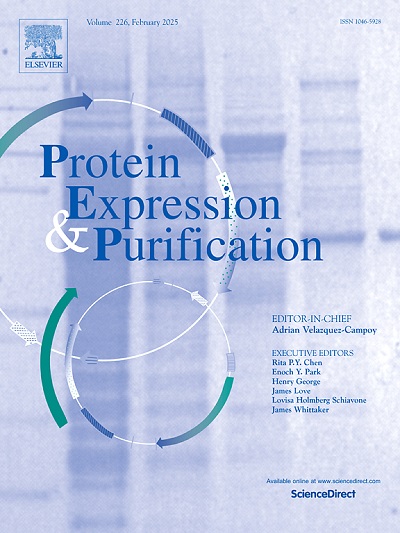活性赖氨酰内肽酶的高效外质粒表达及纯化方法的优化。
IF 1.2
4区 生物学
Q4 BIOCHEMICAL RESEARCH METHODS
引用次数: 0
摘要
蛋白质组学中常用的赖氨酰内肽酶(Lys-C)结构复杂,因此其重组生产仍具有挑战性。本文研究了外质粒表达和确定回收活性酶的有效因素。将经过密码子优化的 Lys-C 基因克隆到 pET26b (+) 中,在大肠杆菌 Rosetta (DE3) 中进行质粒表达。研究了影响 Lys-C 表达水平和活性的参数,包括 IPTG 浓度(0.05-1 mM)、诱导时的细胞密度(OD600:0.45-0.8)、培养基或质外提取缓冲液中还原剂(谷胱甘肽或半胱氨酸,0-10 mM)的存在以及收获时间(6 或 20 小时)。然后用 DEAE 和 Ni-NTA 色谱法纯化 Lys-C。在 0.05 mM IPTG(5.49%)和 8 mM 半胱氨酸条件下,表达水平最高;在 OD600:0.45 和 6 小时孵育条件下,酶活性分别提高到 23.5%、13.3% 和 76.4%。在 4 mM 谷胱甘肽和含有 2 mM 2-巯基乙醇(2ME)的提取缓冲液存在下,Lys-C 的酶活性比不使用还原剂的条件下高 81.6%。此外,在培养基中加入 8 mM 半胱氨酸和在提取过程中加入 2 mM 2ME 可使活性提高 29.7%。此外,优化纯化过程可将酶活性从 0.217 mU 提高到 1.76 mU。统计分析显示,所研究的参数对酶活性有显著影响(p本文章由计算机程序翻译,如有差异,请以英文原文为准。
Efficient periplasmic expression of active lysyl endopeptidase and optimizing the purification methods
Recombinant production of lysyl endopeptidase (Lys-C) which is frequently used in proteomics is still challenging due to its complex structure. Herein, periplasmic expression and determining effective factors for recovery of the active enzyme were investigated. The codon-optimized Lys-C gene was cloned into pET26b (+) for periplasmic expression in E. coli Rosetta (DE3). The following parameters affecting expression level and activity of Lys-C were investigated including IPTG concentration (0.05–1 mM), cell density (OD600: 0.45–0.8) at induction time, presence of reducing agents (glutathione or cysteine, 0–10 mM) in culture medium or periplasmic extraction buffers, and harvesting time (6 or 20 h). Lys-C was then purified by DEAE and Ni-NTA chromatography methods. The highest expression level was obtained at 0.05 mM IPTG (5.49 %), also 8 mM cysteine, induction at OD600: 0.45 and 6 h incubation increased enzyme activity to 23.5 %, 13.3 %, and 76.4 %, respectively. The enzyme activity of Lys-C in the presence of 4 mM glutathione and extraction buffers containing 2 mM 2-mercaptoethanol (2 ME) was 81.6 % higher than the condition without reducing agents. Also, 8 mM cysteine in the culture medium and 2 mM 2 ME in extraction increased the activity up to 29.7 %. Moreover, optimization of purification process enhanced the enzyme activity from 0.217 mU to 1.76 mU. Statistical analysis showed the examined parameters significantly affected enzyme activity (p < 0.05). The presence of the reducing agents in the culture medium and extraction buffers presumably improves the Lys-C folding and increases the enzyme activity.
求助全文
通过发布文献求助,成功后即可免费获取论文全文。
去求助
来源期刊

Protein expression and purification
生物-生化研究方法
CiteScore
3.70
自引率
6.20%
发文量
120
审稿时长
32 days
期刊介绍:
Protein Expression and Purification is an international journal providing a forum for the dissemination of new information on protein expression, extraction, purification, characterization, and/or applications using conventional biochemical and/or modern molecular biological approaches and methods, which are of broad interest to the field. The journal does not typically publish repetitive examples of protein expression and purification involving standard, well-established, methods. However, exceptions might include studies on important and/or difficult to express and/or purify proteins and/or studies that include extensive protein characterization, which provide new, previously unpublished information.
 求助内容:
求助内容: 应助结果提醒方式:
应助结果提醒方式:


